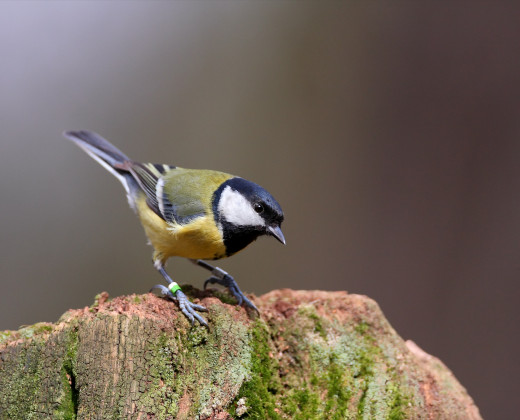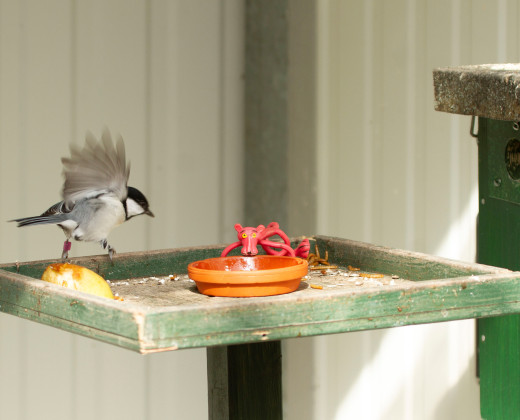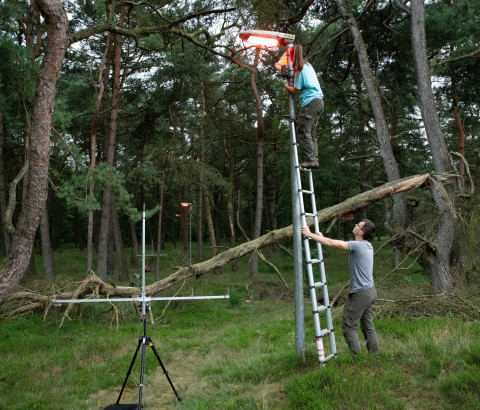Dierecologie
De afdeling Dierecologie onderzoekt waarom dieren bepaalde eigenschappen hebben, hoe dit genetisch bepaald is en hoe dit verandert over tijd en plaats. We kijken bijvoorbeeld naar de verandering van populaties, qua aantallen en qua samenstelling.
We plaatsen verschillende processen, zoals veranderingen in genen, fysiologie, gedrag en populatie in een evolutionair kader. We zijn vooral benieuwd hoe dieren zich aanpassen aan veranderingen veroorzaakt door mensen. Denk aan klimaatverandering en verstedelijking.
De afdeling heeft twee hoofddoelen, die we uiteindelijk willen samenvoegen:
- Evolutionair onderzoek: we willen evolutie niet alleen begrijpen, maar ook voorspellen. Hierbij is het belangrijk om veranderingen in het DNA en epigenetische processen (aanpassingen zonder dat het DNA veranderd) te begrijpen. Om deze veranderingen te voorspellen onderzoeken we hoe klimaatverandering en menselijke activiteiten, zoals landgebruik, dit proces beïnvloeden. We baseren veel van ons onderzoek op langdurige veldstudies en ons onderzoek naar kleine zangvogels in onze volières.
- Ecologisch onderzoek: in ons ecologische onderzoek richten we ons op het voorspellen van populaties. Dit doen we met behulp van modellen. Het grote doel is om de verbanden tussen evolutie en ecologie te begrijpen. En dan vooral hoe menselijke invloeden effect hebben op populaties en hoe evolutie hierin een rol speelt.
Dierecologie4all
Meer weten over het spannende vogelonderzoek van de dierecologen?
Kijk op de Dierecologie4All pagina!
Faciliteiten
Onderzoeksfaciliteiten Dierecologie
Langlopend onderzoek naar populaties
Belangrijk zijn onze langlopende onderzoeken naar zangvogels, zoals koolmezen, pimpelmezen, bonte vliegenvangers en enkele andere soorten. Dit gebeurt op 4 locaties in Nederland (Hoge Veluwe, Vlieland, Oosterhout, Liesbos). Deze studies lopen als sinds 1955 en zijn de langstlopende onderzoeken naar bekende wilde vogels wereldwijd.
De studies hebben 3 hoofddoelen:
- We kijken naar veranderingen in populaties over de jaren heen. Bijvoorbeeld hoe soorten reageren op klimaatverandering.
- We doen op kortere termijn experimenteel onderzoek, waarbij we putten uit de enorme hoeveelheid beschikbare gegevens.
- We werken samen met verschillende onderzoeksgroepen wereldwijd, waarbij onze gegevens gebruikt worden voor nieuwe methoden of als onderdeel van een vergelijkende studie.
Om samenwerkingen met deze partijen makkelijker te maken, hebben we een vogeldatabase gemaakt: Studies of Populations of Individuals – Birds (SPI-Birds). Studies of Populations of Individuals – Birds (SPI-Birds)

Persoonlijkheid van dieren
Ook dieren hebben een persoonlijkheid. Iedereen met een huisdier kan dit bevestigen. Sterker nog, dierenpersoonlijkheid is een van de snelst groeiende onderzoeksgebieden in ecologie en gedragsbiologie. Dierecologie stond aan de wieg van dit onderzoeksveld en heeft over de jaren heen veel gegevens verzameld over hoe dieren zich gedragen in de natuur. Waarom bestaat dierenpersoonlijkheid? Wat veroorzaakt de verschillen in karakter en wat zijn de gevolgen? Met onze langdurige veldonderzoeken en gerichte binnen- en buitenexperimenten proberen we deze vragen te beantwoorden.

Impact van licht
Natuurlijke duisternis vind je ’s nachts alleen nog in afgelegen gebieden. Door economische groei en verstedelijking is er steeds meer kunstlicht. We onderzoeken hoe dit de aanwezigheid, het gedrag en het welzijn van verschillende dieren beïnvloedt. Als we begrijpen hoe dieren op licht reageren, kunnen we problemen voorkomen of verminderen.

Vogeltrek
We volgen al lange tijd vogels tijdens hun reizen, zoals de kleine zwanen sinds de jaren ‘90. Door sensoren en GPS te gebruiken, kunnen we precies zien waar ze zijn en wat ze doen. Zo kunnen we bijvoorbeeld zien of ze succesvol broeden. Door vogels jarenlang te volgen, zien we hoe ze hun routes aanpassen door veranderingen, vaak veroorzaakt door mensen. Ook gebruiken we vogels als indicatoren voor veranderingen in hun omgeving. We werken hiervoor nauw samen met Vogeltrekstation: https://vogeltrekstation.nl/
Medewerkers
-
Prof. dr. Marcel E. Visser
- Functie
- Afdelingshoofd

-
Prof. dr. Bart A. Nolet
- Functie
- Senior Researcher

-
Prof. dr. Kees van Oers
- Functie
- Senior Researcher

-
Dr. Melissah Rowe
- Functie
- Senior Researcher

-
Dr. ir. Kamiel Spoelstra
- Functie
- Researcher

Evenementen
Peer-reviewed publicaties
Dimming streetlights in urban areas reduces insect attraction but pipistrelle bats forage more in darkness
Early-life viability selection targets deleterious mutations in exons
One Health approach uncovers emergence and dynamics of Usutu and West Nile viruses in the Netherlands
Exposure to high temperatures is fatal for eggs and suppresses growth in a false widow spider, Steatoda grossa
Evaluating the demographic impacts of the highly pathogenic avian influenza panzootic
Arctic geese in newly colonised, colder breeding areas have higher spring body mass and breed earlier relative to the onset of spring
Local dominance predicts foraging decisions in a changing environment
Adult survival has a stronger role than productivity in the annual population change of European songbirds
Temperature predictability and introduction history affect the expression of genes regulating DNA methylation in a globally distributed songbird
Phenological Plasticity and Its Temperature-Related Drivers in Common Songbirds Across Europe
Historical insecticide applications for the treatment of forest insect pests from 1968 to 2017, in Nova Scotia and Newfoundland and Labrador, Canada
Multi-year water level drawdown and wildlife grazing drive wetland vegetation succession
A large-scale study across the avian clade identifies ecological drivers of neophobia
Assignment of wintering Barnacle Geese (Branta leucopsis) to breeding populations using genome-wide single-nucleotide polymorphisms
Long-distance dispersal is asymmetrical with respect to age, sex and breeding latitude in a long-lived monogamous bird
Scope for waterfowl to speed up migration to a warming Arctic
Simulated bacterial infection induces different changes in DNA methylation between introduced and native house sparrows Passer domesticus
Linking Individual Performance to Density-Dependent Population Dynamics to Understand Temperature-Mediated Genotype Coexistence
Limited immediate effect of artificial light of realistic intensity on flight behaviour of commuting pond bat (Myotis dasycneme)
Library of Identification Resources
Independent evolution of atypical sperm morphology in a passerine bird
Predicted deleterious mutations reveal the genetic architecture of male reproductive success in a lekking bird
Recreational and Aesthetic Values of Forest Landscapes (RAFL)
Multigenerational fitness outcomes of double-brooding
Parental control
Diel rhythmicity of activity and corticosterone metabolites in Arctic barnacle geese during breeding
Phenology and flower species availability define wild bee communities on river embankments
Intensity and colour of artificial light at night affect insect attraction in a taxon‐dependent manner
Experimental Usutu virus infection in Eurasian blackbirds (Turdus merula)
Variation in migration distance does not affect arrival date in the subsequent breeding season of Dutch barn swallows Hirundo rustica
A multi-species model for goose management
Host–Microbiome Interactions as Moderators of Host Quality and Biodiversity–Disease Relationships
Temperature amplifies the effect of anthropogenic light on foraging common pipistrelle bats
Independent Avian Epigenetic Clocks for Ageing and Development
Usutu Virus Antibody Dynamics in Naturally Infected Blackbirds, the Netherlands, 2016-2018
Spatio‐temporal Usutu virus model explains Eurasian blackbird Turdus merula population trends
Population density and timing of breeding mediate effects of early life conditions on recruitment
Local Circulation of Sindbis Virus in Wild Birds and Horses, the Netherlands, 2021–2022
Individual Variation in Migration and Wintering Patterns of Long‐Tailed Ducks Clangula hyemalis From a Population in Decline
Migratory Birds Advance Spring Arrival and Egg‐Laying in the Arctic, Mostly by Travelling Faster
Weather anomalies cannot explain insect decline
Size in the city
Associations between human non‐motorised recreational activity on nest box occupation, exploratory behaviour and breeding success in a passerine bird
Eoldist, a Web Application for Estimating Cautionary Detection Distance of Birds by Automatic Detection Systems to Reduce Collisions With Wind Turbines
Simulating and Analysing Seabird Flyways
Continent-Wide Drivers of Spatial Synchrony in Breeding Demographic Structure Across Wild Great Tit Populations
Geographic differences in the phenology of gonadal development and moult, but not of egg laying, are genetically based in a small songbird
Microbial surveillance versus cytokine responsiveness in native and non-native house sparrows
Ten simple rules for good model-sharing practices
Copulation interruption decreases female reproductive success in a false widow spider
DNA Methylation Associates With Sex-Specific Effects of Experimentally Increased Yolk Testosterone in Wild Nestlings
The extent of amphibian, fish and water plant translocations by garden pond owners
Code-sharing policies are associated with increased reproducibility potential of ecological findings
Effects of immune status on stopover departure decisions are subordinate to those of condition, cloud cover and tailwind in autumn‐migrating common blackbirds Turdus merula
Are comparable studies really comparable? Suggestions from a problem-solving experiment on urban and rural great tits
Overwintering of Usutu virus in mosquitoes, The Netherlands
Understanding human-commensalism through an ecological and evolutionary framework
Female reproductive tract microbiota varies with MHC profile
Migrating shorebird killed by raptor at 3000 m above ground as revealed by high‐resolution tracking
DARTS: Modelling effects of shocks on global, regional, urban and rural food security
Effects of age, breeding strategy, population density, and number of neighbors on territory size and shape in Passerculus sandwichensis (Savannah Sparrow)
Sentinel chicken surveillance reveals previously undetected circulation of West Nile virus in the Netherlands
The European Reference Genome Atlas: piloting a decentralised approach to equitable biodiversity genomics
Limited sensitivity of permafrost soils to heavy rainfall across Svalbard ecosystems
Circadian clock period length is not consistently linked to chronotype in a wild songbird
Unveiling the roles of temporal periodicity, the spatial environment and behavioural modes in terrestrial animal movement
Artificial light at night drives diel activity patterns of synanthropic pipistrelle bats and their prey
Tracking data as an alternative to resighting data for inferring population ranges
Climatic Predictors of Long-Distance Migratory Birds Breeding Productivity Across Europe
Advances in Black-tailed Godwit Limosa limosa limosa conservation research over the last 15 years
Early-life diet composition affects phenotypic variation of correlated animal personality traits
Seasonal and environmental factors contribute to the variation in the gut microbiome
Ixodes ricinus as potential vector for Usutu virus
Variation in avian chronotype
Revisiting Perdeck's massive avian migration experiments debunks alternative social interpretations
Sea-level rise causes shorebird population collapse before habitats drown
The great tit HapMap project
Genetic and epigenetic differentiation in response to genomic selection for avian lay date
Bats in the spotlight
Frequency‐dependent tolerance to aircraft disturbance drastically alters predicted impact on shorebirds
Supporting study registration to reduce research waste
Observation of female-male mounting in the carrion crow
A country-wide examination of effects of urbanization on common birds
Consequences of alternative stable states for short-term model-based control of cyanobacterial blooms
Quantifying the mutualism-antagonism continuum for seed removal by a granivorous disperser
Effects of capture and GPS-tagging in spring on migration timing and reproduction in Pink-footed geese Anser brachyrhynchus
Odours of caterpillar-infested trees increase testosterone concentrations in male great tits
Temperature has an overriding role compared to photoperiod in regulating the seasonal timing of winter moth egg hatching
Early developmental carry‐over effects on exploratory behaviour and DNA methylation in wild great tits (Parus major)
Mapping wing morphs of Tetrix subulata using citizen science data: Flightless groundhoppers are more prevalent in grasslands near water
Are increasing roosting waterbird numbers responsible for eutrophication of shallow lakes? Examples from a Danish Ramsar site
Systematic approaches to assessing high temperature limits to fertility in animals
Short-time exposure to light at night affects incubation patterns and correlates with subsequent body weight in great tits (Parus major)
Divergence in evolutionary potential of life history traits among wild populations is predicted by differences in climatic conditions
More management, less damage? With increasing population size, economic costs of managing geese to minimize yield losses may outweigh benefits
Development and validation of the MosquitoWise survey to assess perceptions towards mosquitoes and mosquito-borne viruses in Europe
DARTS: Evolving Resilience of the Global Food System to Production and Trade Shocks
A systematic map of studies testing the relationship between temperature and animal reproduction
Long-term exposure to experimental light affects the ground-dwelling invertebrate community, independent of light spectra
Snowmelt progression drives habitat selection and vegetation disturbance by an Arctic avian herbivore
The role of male body size in mating success and male–male competition in a false widow spider
Author Correction
Structural genomic variation and migratory behavior in a wild songbird
Earlier springs increase goose breeding propensity and nesting success at Arctic but not at temperate latitudes
Climate change does not equally affect temporal patterns of natural selection on reproductive timing across populations in two songbird species
Female pond bats hunt in other areas than males and consume lighter prey when pregnant
The genomics of adaptation to climate in European great tit (Parus major) populations
Probing variation in reaction norms in wild populations
Implementing code review in the scientific workflow
Extreme events, trophic chain reactions, and shifts in phenotypic selection
Geese colonising New Land
Demographic signals of population decline and time to extinction in a seasonal, density-dependent model






